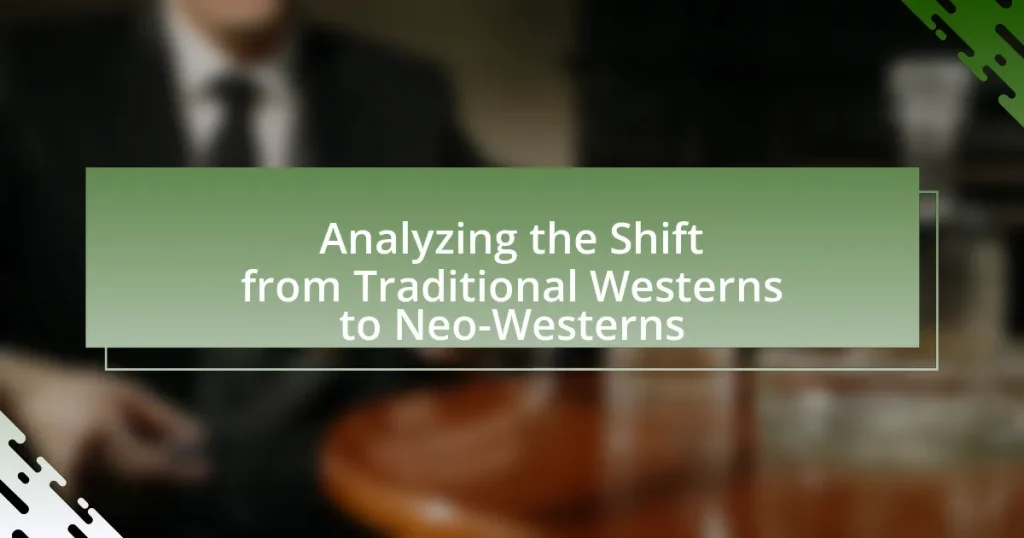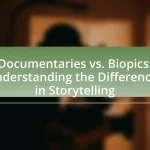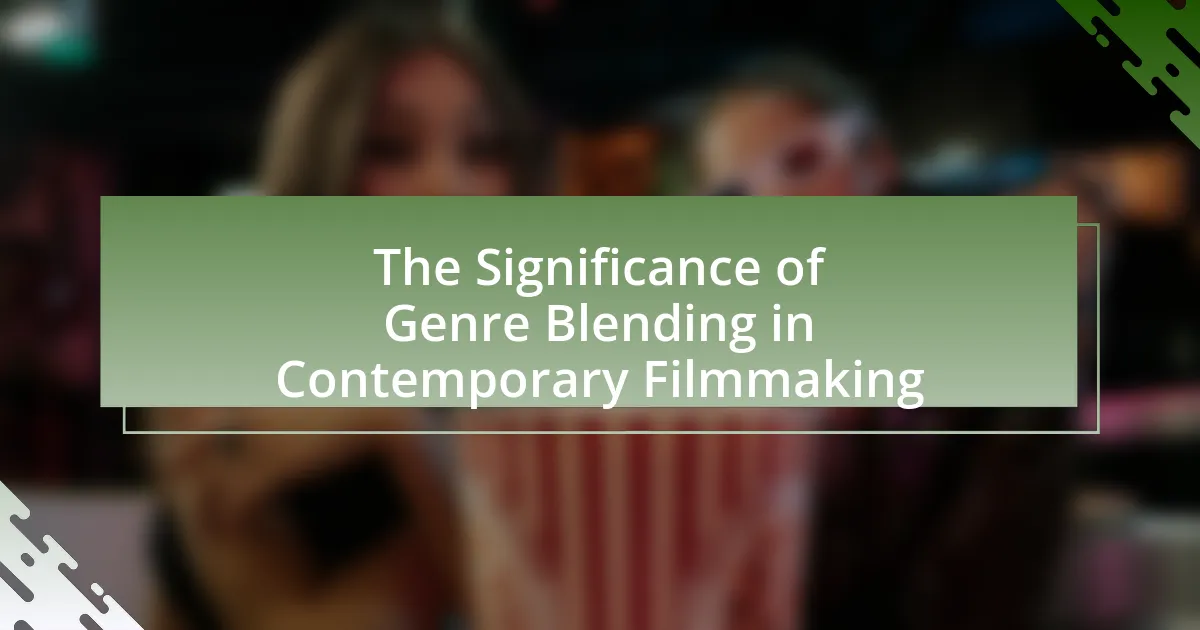The article analyzes the transition from Traditional Westerns to Neo-Westerns, highlighting the defining characteristics and themes of each genre. Traditional Westerns are characterized by their portrayal of the American frontier, featuring clear moral dichotomies and iconic figures such as cowboys and outlaws. In contrast, Neo-Westerns incorporate contemporary themes, moral ambiguity, and complex character development, addressing modern societal issues like identity and justice. The article also discusses the cultural changes influencing this shift, the evolution of audience perceptions, and the implications for storytelling and representation in the Western genre.
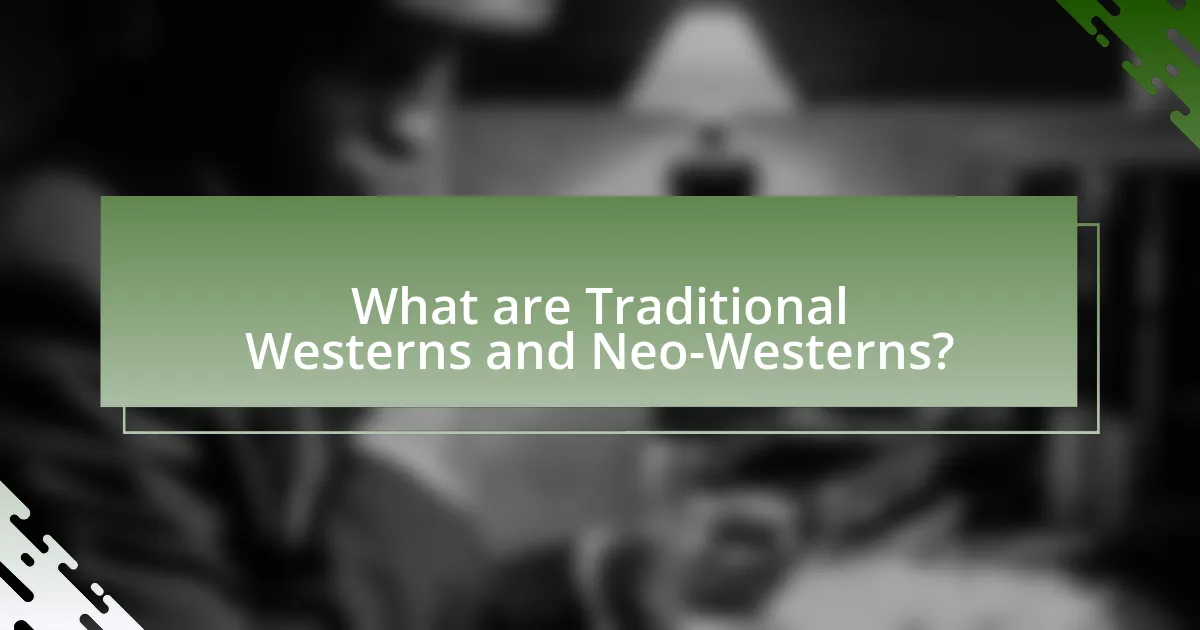
What are Traditional Westerns and Neo-Westerns?
Traditional Westerns are a genre of film and literature that typically depict the American West during the late 19th century, characterized by themes of rugged individualism, lawlessness, and the conflict between civilization and the wilderness. These narratives often feature iconic elements such as cowboys, outlaws, and Native Americans, with a clear moral dichotomy between good and evil.
Neo-Westerns, on the other hand, are a modern reinterpretation of the Western genre that incorporates contemporary themes, complex characters, and social issues, often set in modern or near-modern contexts. Unlike Traditional Westerns, Neo-Westerns explore moral ambiguity and the consequences of violence, reflecting current societal challenges. Examples include films like “No Country for Old Men” and “Hell or High Water,” which maintain Western motifs while addressing modern dilemmas.
How do Traditional Westerns define the genre?
Traditional Westerns define the genre through their characteristic themes, settings, and archetypal characters. These films typically portray the American frontier during the late 19th century, emphasizing the conflict between civilization and wilderness. Key elements include the heroic cowboy, often depicted as a lone figure upholding justice, and the presence of clear moral dichotomies, such as good versus evil. The genre also frequently incorporates iconic settings like saloons, dusty towns, and vast landscapes, which serve as backdrops for narratives centered on lawlessness, personal honor, and the struggle for survival. The influence of Traditional Westerns is evident in their lasting impact on American culture and cinema, shaping the expectations and conventions of subsequent Western narratives.
What are the key characteristics of Traditional Westerns?
Traditional Westerns are characterized by their depiction of the American frontier, focusing on themes of individualism, morality, and the conflict between civilization and wilderness. These films often feature iconic elements such as cowboys, outlaws, and lawmen, set against vast landscapes that symbolize freedom and adventure. The narrative typically revolves around a clear distinction between good and evil, with protagonists embodying heroic traits and antagonists representing lawlessness. Additionally, traditional Westerns frequently incorporate elements of gunfights, horseback riding, and saloons, reinforcing the genre’s historical context and cultural significance in American cinema.
Who are the iconic figures in Traditional Westerns?
Iconic figures in Traditional Westerns include John Wayne, Clint Eastwood, and Gary Cooper. John Wayne, known for his roles in films like “Stagecoach” and “True Grit,” epitomized the rugged cowboy archetype and became a symbol of American masculinity. Clint Eastwood, with his portrayal of the “Man with No Name” in Sergio Leone’s Spaghetti Westerns, redefined the genre’s hero with a more complex, morally ambiguous character. Gary Cooper, recognized for his performances in “High Noon” and “The Westerner,” represented the classic Western hero who embodies integrity and courage. These actors significantly shaped the Western genre and left a lasting impact on American cinema.
What distinguishes Neo-Westerns from Traditional Westerns?
Neo-Westerns are distinguished from Traditional Westerns primarily by their thematic complexity and character development. While Traditional Westerns often portray clear moral dichotomies and archetypal heroes and villains, Neo-Westerns delve into moral ambiguity, exploring the psychological and social issues faced by characters. For example, films like “No Country for Old Men” and “The Assassination of Jesse James by the Coward Robert Ford” illustrate this shift by presenting flawed protagonists and a more nuanced view of justice and morality. This evolution reflects broader societal changes and a departure from the simplistic narratives of earlier Westerns.
How do themes in Neo-Westerns differ from those in Traditional Westerns?
Themes in Neo-Westerns differ from those in Traditional Westerns primarily through their focus on moral ambiguity and complex character development. Traditional Westerns often depict clear distinctions between good and evil, with heroes embodying idealized traits and villains representing straightforward threats. In contrast, Neo-Westerns explore the gray areas of morality, presenting protagonists who grapple with personal flaws and societal issues, reflecting contemporary concerns such as identity, justice, and the impact of modernity on traditional values. For example, films like “No Country for Old Men” illustrate this shift by showcasing characters whose motivations and actions are not easily categorized, emphasizing the unpredictability of human nature and the consequences of violence in a changing world.
What stylistic elements are unique to Neo-Westerns?
Neo-Westerns uniquely incorporate stylistic elements such as complex character development, moral ambiguity, and contemporary social issues. Unlike traditional Westerns that often depict clear-cut heroes and villains, Neo-Westerns present protagonists with flawed personalities and ambiguous motivations, reflecting modern societal complexities. Additionally, these films frequently address current themes such as environmentalism, immigration, and systemic injustice, which resonate with contemporary audiences. This shift in narrative focus allows for a deeper exploration of human experiences and societal challenges, distinguishing Neo-Westerns from their traditional counterparts.
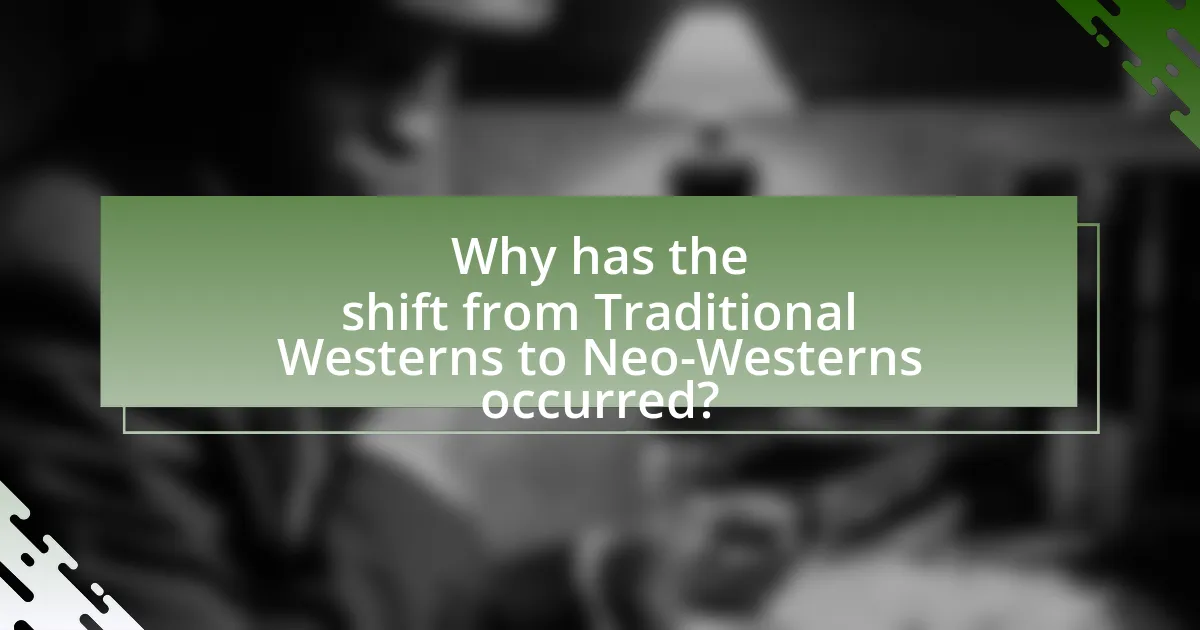
Why has the shift from Traditional Westerns to Neo-Westerns occurred?
The shift from Traditional Westerns to Neo-Westerns has occurred primarily due to changing societal values and audience expectations. Traditional Westerns often portrayed clear moral dichotomies and simplistic narratives, reflecting the values of their time. In contrast, Neo-Westerns incorporate complex characters, moral ambiguity, and contemporary issues, resonating with modern audiences who seek deeper storytelling. This evolution is evidenced by films like “No Country for Old Men” and “The Assassination of Jesse James by the Coward Robert Ford,” which challenge traditional tropes and explore themes of violence, identity, and existentialism, aligning with current cultural dialogues.
What cultural changes have influenced this shift?
The cultural changes that have influenced the shift from traditional Westerns to neo-Westerns include evolving societal values, increased representation of diverse perspectives, and a growing critique of historical narratives. As societal values have shifted towards inclusivity and social justice, neo-Westerns often reflect contemporary issues such as race, gender, and morality, contrasting with the more simplistic portrayals in traditional Westerns. For instance, films like “The Harder They Fall” showcase Black cowboys and challenge stereotypes, highlighting the importance of representation. Additionally, the rise of postmodernism has led to a questioning of traditional narratives, prompting filmmakers to explore complex characters and ambiguous moralities, as seen in works like “No Country for Old Men.” These cultural changes underscore a broader transformation in storytelling that resonates with modern audiences.
How have societal values evolved in relation to Western narratives?
Societal values have evolved significantly in relation to Western narratives, shifting from glorifying individualism and rugged masculinity to embracing diversity, inclusivity, and moral complexity. Traditional Westerns often depicted a clear dichotomy between good and evil, reinforcing stereotypes of heroism and villainy, while contemporary neo-Westerns reflect a more nuanced understanding of morality, showcasing characters with multifaceted identities and motivations. This evolution is evidenced by films like “Unforgiven” and “No Country for Old Men,” which challenge the archetypal hero and explore themes of redemption, guilt, and the consequences of violence, aligning with modern societal values that prioritize empathy and social justice.
What role does audience perception play in the evolution of the genre?
Audience perception significantly influences the evolution of the genre by shaping the themes, narratives, and character archetypes that resonate with viewers. As audiences’ values and societal norms change, genres adapt to reflect these shifts; for instance, the transition from traditional Westerns, which often glorified rugged individualism and clear moral binaries, to neo-Westerns, which explore complex characters and moral ambiguity, illustrates this evolution. The success of neo-Westerns like “No Country for Old Men” and “Hell or High Water” demonstrates how contemporary audiences favor nuanced storytelling that addresses modern issues such as violence, justice, and identity, thereby driving filmmakers to innovate within the genre.
How has the film industry adapted to changing trends?
The film industry has adapted to changing trends by evolving its storytelling techniques and embracing new technologies. For instance, the shift from traditional Westerns to neo-Westerns reflects a broader cultural shift, where filmmakers incorporate contemporary themes such as social justice and moral ambiguity, appealing to modern audiences. This adaptation is evidenced by films like “No Country for Old Men” and “Hell or High Water,” which retain Western elements while addressing current societal issues. Additionally, advancements in streaming technology have transformed distribution methods, allowing for diverse narratives to reach wider audiences, further demonstrating the industry’s responsiveness to changing viewer preferences.
What impact have technological advancements had on Western storytelling?
Technological advancements have significantly transformed Western storytelling by enhancing visual effects, enabling complex narratives, and expanding distribution methods. The introduction of CGI and advanced cinematography techniques has allowed filmmakers to create more immersive and visually stunning representations of the Western genre, as seen in films like “The Revenant,” which utilized cutting-edge technology to depict realistic landscapes and action sequences. Additionally, streaming platforms have revolutionized how Western stories reach audiences, allowing for diverse interpretations and adaptations, such as the series “Westworld,” which blends traditional Western themes with science fiction elements. This shift not only broadens the narrative scope but also engages a wider audience, reflecting contemporary societal issues within the Western framework.
How do modern filmmakers reinterpret classic Western tropes?
Modern filmmakers reinterpret classic Western tropes by subverting traditional narratives and character archetypes, often emphasizing moral ambiguity and complex social issues. For instance, films like “No Country for Old Men” and “The Assassination of Jesse James by the Coward Robert Ford” challenge the clear-cut distinctions between good and evil, presenting protagonists and antagonists with nuanced motivations. Additionally, contemporary Westerns frequently incorporate themes of race, gender, and class, reflecting modern societal concerns; for example, “The Harder They Fall” showcases a predominantly Black cast and addresses historical injustices. This shift not only revitalizes the genre but also engages audiences with relevant cultural dialogues, demonstrating the evolution of storytelling within the Western framework.
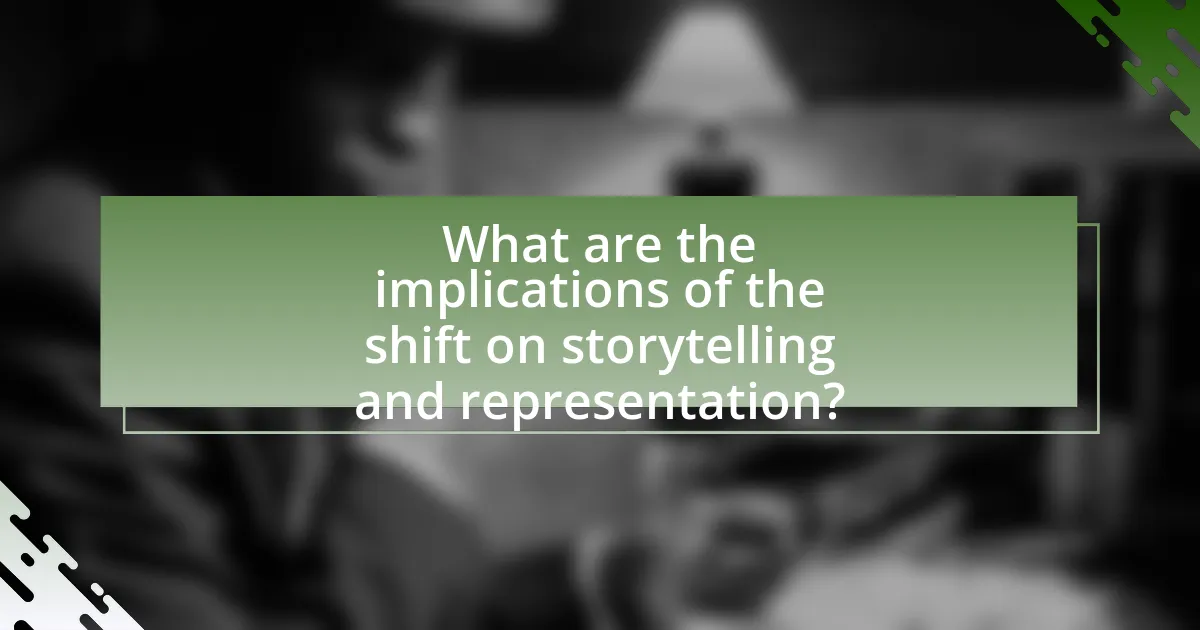
What are the implications of the shift on storytelling and representation?
The implications of the shift from traditional Westerns to neo-Westerns significantly alter storytelling and representation by introducing diverse perspectives and complex characters. This transition reflects a broader cultural awareness, allowing for narratives that challenge stereotypes and explore themes of identity, morality, and social justice. For instance, neo-Westerns often feature protagonists from marginalized backgrounds, which contrasts with the predominantly white male heroes of traditional Westerns. This shift not only enriches the storytelling landscape but also resonates with contemporary audiences seeking authenticity and relatability in media. The evolution in representation fosters a more inclusive dialogue about the American experience, as seen in films like “The Harder They Fall,” which reimagines the Western genre through a Black lens, highlighting the importance of diverse narratives in reshaping cultural perceptions.
How do Neo-Westerns address contemporary social issues?
Neo-Westerns address contemporary social issues by reinterpreting traditional Western themes through modern lenses, often highlighting topics such as racial inequality, gender dynamics, and environmental concerns. For instance, films like “Hell or High Water” explore economic disparity and the struggles of rural communities, reflecting current societal challenges. Additionally, “The Harder They Fall” showcases Black representation in a genre historically dominated by white narratives, thereby addressing racial issues and promoting diversity. These films utilize the Western genre’s familiar settings and archetypes to engage with and critique modern social realities, making them relevant to today’s audiences.
What themes of identity and morality are explored in Neo-Westerns?
Neo-Westerns explore themes of identity and morality by examining the complexities of modern characters against the backdrop of traditional Western settings. These narratives often challenge conventional notions of heroism and villainy, presenting morally ambiguous characters who grapple with personal and societal conflicts. For instance, films like “No Country for Old Men” illustrate the struggle between old moral codes and contemporary ethical dilemmas, highlighting how identity is shaped by both personal choices and external circumstances. This shift reflects a broader commentary on the evolving nature of morality in a changing world, where characters must navigate their identities amidst violence, lawlessness, and existential questions.
How do Neo-Westerns represent marginalized voices compared to Traditional Westerns?
Neo-Westerns represent marginalized voices more prominently than Traditional Westerns by incorporating diverse perspectives and addressing social issues related to race, gender, and class. Traditional Westerns often centered on white male protagonists, reinforcing stereotypes and neglecting the experiences of Indigenous peoples, women, and other marginalized groups. In contrast, Neo-Westerns, such as “Hell or High Water” and “The Harder They Fall,” feature complex characters from varied backgrounds, highlighting their struggles and contributions to the narrative. This shift reflects a broader cultural awareness and a desire for inclusivity, as evidenced by the increasing representation of Indigenous actors and stories in contemporary films, which challenge historical inaccuracies and promote a more nuanced understanding of the American West.
What can we learn from the evolution of the Western genre?
The evolution of the Western genre teaches us about the changing cultural values and societal issues reflected in American cinema. Traditional Westerns often emphasized themes of heroism, individualism, and the romanticized frontier, as seen in films like “Stagecoach” (1939) and “The Searchers” (1956). In contrast, neo-Westerns, such as “No Country for Old Men” (2007) and “Hell or High Water” (2016), address contemporary themes like moral ambiguity, economic hardship, and the complexities of modern life. This shift illustrates how the genre adapts to reflect the audience’s evolving perspectives on justice, identity, and community, demonstrating the Western’s relevance in addressing both historical and modern American experiences.
How can filmmakers balance tradition and innovation in Western storytelling?
Filmmakers can balance tradition and innovation in Western storytelling by integrating classic narrative elements with contemporary themes and techniques. This approach allows filmmakers to honor the genre’s roots, such as archetypal characters and moral dilemmas, while also addressing modern societal issues like diversity and environmental concerns. For instance, films like “No Country for Old Men” and “The Assassination of Jesse James by the Coward Robert Ford” exemplify this balance by maintaining traditional Western aesthetics while exploring complex psychological and ethical questions relevant to today’s audience. This blend not only preserves the essence of Western storytelling but also revitalizes it for new generations, ensuring its continued relevance and appeal.
What best practices can be applied to future Western narratives?
Future Western narratives should prioritize inclusivity and diverse perspectives to reflect contemporary societal values. This approach can be seen in successful neo-Westerns like “The Harder They Fall,” which features a predominantly Black cast and reimagines historical narratives. By incorporating varied cultural backgrounds and experiences, future Westerns can resonate more deeply with a broader audience, as evidenced by the increasing popularity of films that challenge traditional tropes. Additionally, integrating complex character development and moral ambiguity can enhance storytelling, moving away from one-dimensional portrayals typical of classic Westerns. This shift aligns with audience preferences for nuanced narratives, as demonstrated by the critical acclaim of series like “Westworld,” which blends Western themes with science fiction and ethical dilemmas.
